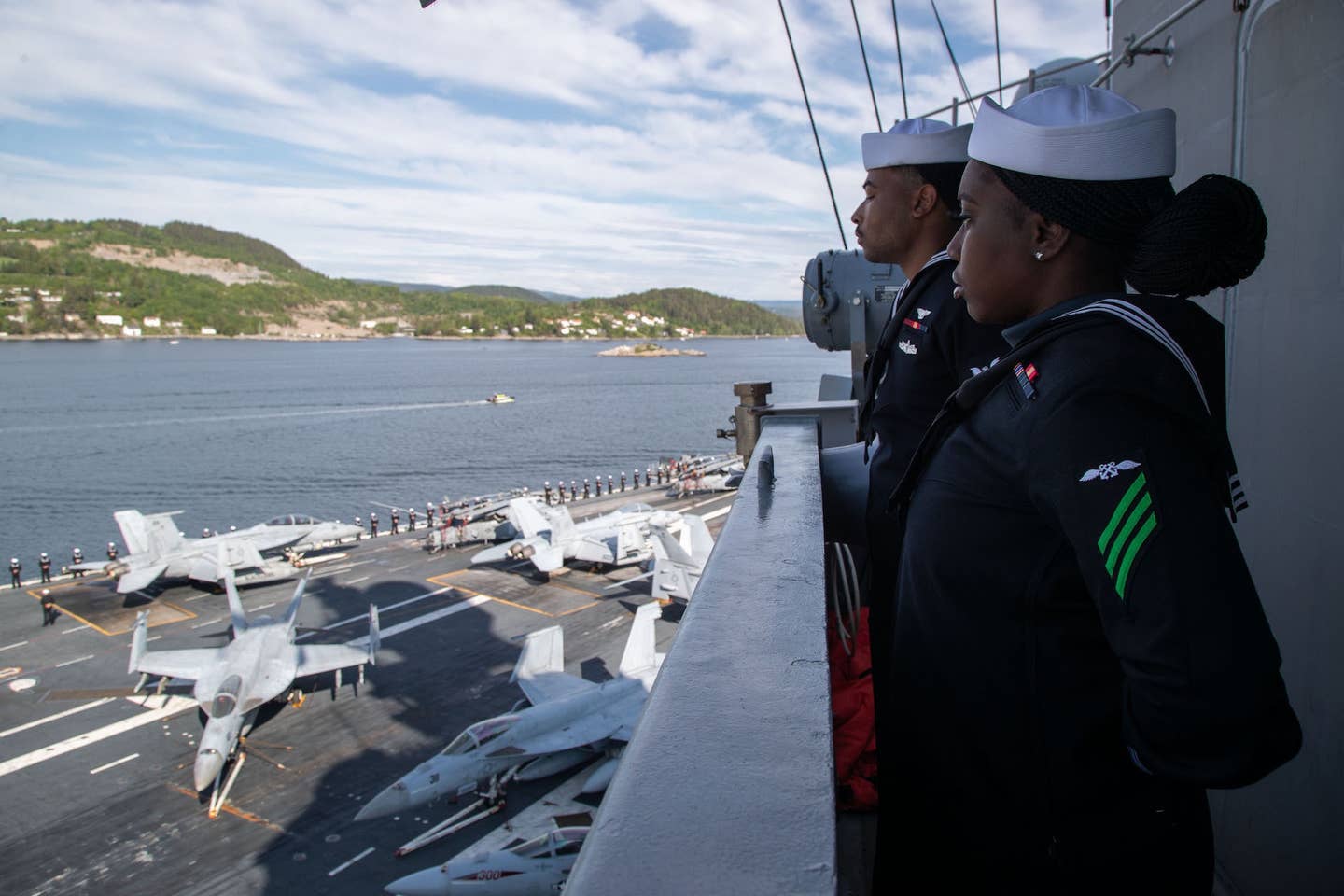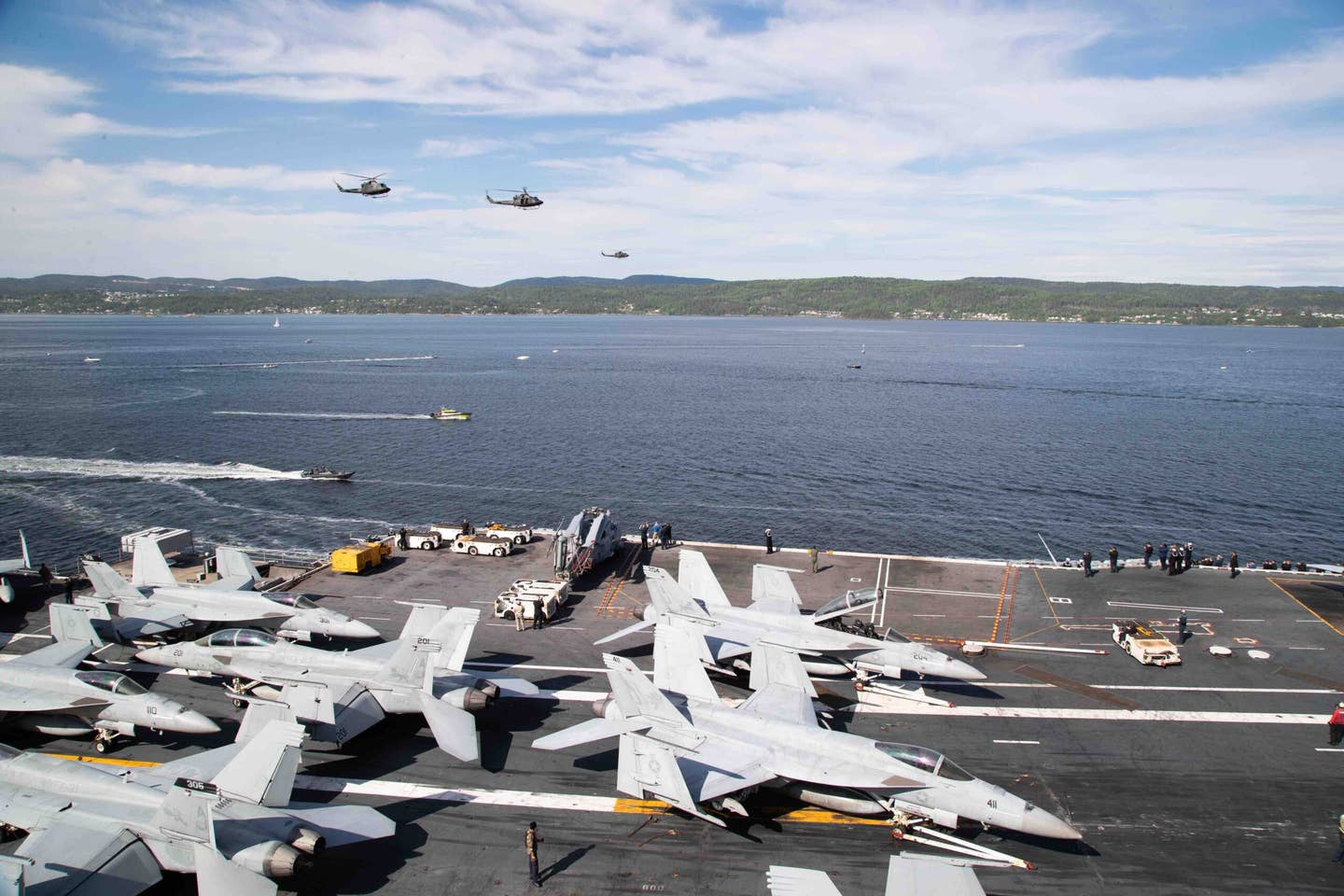The USS Gerald R. Ford, the U.S. Navy’s newest supercarrier, made its historic arrival in Oslo on the morning of May 24, marking the first visit of a U.S. flattop to Norway in more than sixty years.
China Launches ‘Great Stealth’ Attack On US’ Key Military Location; NYT Says Malware Targeted Telcom In Guam
The arrival at Oslo serves as the first port of call for the USS Gerald R. Ford’s maiden operational mission, signifying a notable shift in priorities for NATO navies.
With tensions rising with Russia, there has been a growing emphasis on the North Atlantic and Arctic waters by NATO forces.
Setting sail from Norfolk, Virginia, on May 2, the USS Gerald R. Ford embarked on its maiden voyage as an integral part of a carrier strike group.
Deployed to the U.S. Navy Europe-Africa area of operations, the ship has actively engaged in joint and combined training exercises and operations, as stated by the Navy in a press release.
??-?? Enhancing partnerships! @usnavy’s newest aircraft carrier, USS Gerald R. Ford (CVN 78), arrived in Oslo, Norway, for a scheduled port visit, marking the first time a U.S. aircraft carrier has visited Norway in 65 years.
Read more: https://t.co/XaxCM1h0mn pic.twitter.com/K0N7WFLaSp
— U.S. Naval Forces Europe-Africa/U.S. Sixth Fleet (@USNavyEurope) May 24, 2023
During its operations in the North Sea on May 22, the USS Gerald R. Ford received a visit from officials representing both the United States and Norway.
According to the Navy, the carrier has successfully integrated a Norwegian frigate into its strike group, showcasing the interoperability between the two nations and emphasizing the development of collective operational expertise at sea.
Nonetheless, the visit holds great importance for the USS Gerald R. Ford. The aircraft carrier has embarked on its first full-length cruise, following several years of technical challenges and setbacks since its official delivery to the Navy four years ago.
Also, the visit aligns with the increasing military cooperation between the United States and Norway, particularly in response to heightened military pressures from Russia in the Arctic Circle.

Videos capturing the USS Gerald R. Ford’s transit through the Oslofjord, a crucial waterway connecting Oslo to the North Sea, have been widely shared on social media platforms.
Jonny Karlsen, a spokesperson for the Norwegian Joint Headquarters, the operational command center of the military, said, “This visit is an important signal of the close bilateral relationship between the U.S. and Norway and a signal of the credibility of collective defense and deterrence.”
USS Gerald R. Ford
The USS Gerald R. Ford boasts impressive dimensions, measuring approximately 1,092 feet (333 meters) in length, with a beam of 256 feet (78 meters) at its flight deck, and standing at a height of 250 feet (76 meters).
The USS Gerald R. Ford has faced notable challenges related to its catapults and arresting gear systems, which have held significant importance for the carrier.
These systems are crucial as the Navy contends they enhance the Ford-class carriers’ ability to generate higher sortie rates than their Nimitz-class predecessors. However, issues surrounding their development and implementation have posed substantial hurdles.
Moreover, the overall cost of the USS Gerald R. Ford has experienced a considerable increase in recent years. The Navy has set a cost ceiling of $13.2 billion for the project, highlighting the efforts to control expenses.
The USS Gerald R. Ford is widely regarded as the United States’ most technologically advanced aircraft carrier. Its advanced capabilities have drawn the attention of countries like China, which perceive this warship as a significant challenge to their global ambitions.

In fact, recent wargame simulations conducted by Chinese military researchers have depicted scenarios where a limited number of hypersonic missiles are employed to sink this formidable U.S. Navy aircraft carrier.
These simulations reflect rival nations’ strategic concerns and efforts to develop countermeasures against advanced naval assets like the USS Gerald R. Ford.
Presently, the USS Gerald R. Ford is deployed in Oslo as a part of the Gerald R. Ford Carrier Strike Group (GRFCSG). The strike group is actively engaged in a scheduled deployment within the area of operation of US Naval Forces Europe-Africa/U.S. Sixth Fleet.
Prior to this deployment, the GRFCSG successfully concluded the Composite Training Unit Exercise (COMPTUEX) on April 3.
COMPTUEX is specifically designed to rigorously assess and evaluate the defensive capabilities of carrier strike groups in preparation for forthcoming deployments.
The USS Gerald R. Ford deployment takes place against the backdrop of strengthened interoperability between U.S. and Norwegian forces in recent years. This enhanced cooperation stems from the strategic and geographical importance of Norway.
As a NATO member, Norway plays a vital role in regional security. Notably, the country shares a 198-kilometer-long (123-mile-long) border with Russia.
Also, Norway’s positioning in the highly strategic GIUK gap, a critical bottleneck for Russian submarine activity, adds to its significance.
Moreover, with its extensive coastline stretching into the Arctic region, Norway holds increasing importance in the context of evolving dynamics in the Arctic and its emerging strategic value.
- Contact the author at ashishmichel(at)gmail.com
- Follow EurAsian Times on Google News




